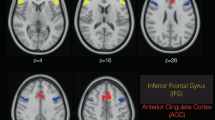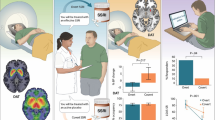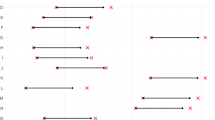Abstract
Numerous findings indicate alterations in brain serotonin systems in obsessive-compulsive disorder (OCD). We investigated the in vivo availability of thalamus–hypothalamus serotonin transporters (SERT) in patients with DSM-IV OCD who displayed prominent behavioral checking compulsions (OC-checkers). Four hours after injection of [123I]-2β-carbomethoxy-3β-(4-iodophenyl)tropane ([123I]-β-CIT), single photon emission computed tomography (SPECT) scans were performed in 24 medication-free non-depressed OC-checkers and 24 age- and gender-matched healthy controls. For quantification of brain serotonin transporter availability, a ratio of specific to non-displaceable [123I]-β-CIT brain binding was used (V″3=(thalamus and hypothalamus−cerebellum)/cerebellum). Drug-free non-depressed OC-checkers showed an 18% reduced brain serotonin transporter availability in the thalamus and hypothalamus, as compared with healthy control subjects (1.38±0.19 vs 1.69±0.21; p<0.001). There was a strong negative correlation between severity of OC symptomatology (Y-BOCS scores) and SERT availability (r=−0.80; p<0.001). Moreover, we found a significant positive correlation between illness duration and serotonin transporter availability (r=0.43; p<0.05). This first report of significantly reduced [123I]-β-CIT binding in the thalamus–hypothalamus region in OC-checkers suggests reduced brain serotonin transporter availability, which is more pronounced with increased severity of OC symptomatology and short duration of illness. The results provide direct evidence for an involvement of the serotonergic system in the pathophysiology of OCD.
Similar content being viewed by others

Log in or create a free account to read this content
Gain free access to this article, as well as selected content from this journal and more on nature.com
or
References
American Psychiatric Association (1994). Diagnostic and Statistical Manual of Mental Disorders, 4th edn. American Psychiatric Press: Washington, DC.
Bäckström I, Bergström M, Marcusson J (1989). High affinity [3H] paroxetine binding to serotonin uptake sites in human brain tissue. Brain Res 486: 261–268.
Barr LC, Goodman WK, McDougle CJ, Delgado PL, Heninger GR, Charney DS et al (1994). Tryptophan depletion in patients with obsessive-compulsive disorder who respond to serotonin reuptake inhibitors. Arch Gen Psychiatry 51: 309–317.
Baumgarten HG, Grozdanovic Z (1998). Role of serotonin in obsessive-compulsive disorder. Br J Psychiatry 173 (Suppl 35): 13–20.
Berney A, Sookman D, Leyton M, Young SN, Benkelfat C (2006). Lack of effects on core obsessive-compulsive symptoms of tryptophan depletion during symptom provocation in remitted obsessive-compulsive disorder patients. Biol Psychiatry 59: 853–857.
Boja JW, Mitchell WM, Patel A, Kopajtic TA, Carroll FI, Lewin AH et al (1992). High-affinity binding of [125I]RTI-55 to dopamine and serotonin transporters in rat brain. Synapse 12: 27–36.
Brücke T, Kornhuber J, Angelberger P, Asenbaum S, Frassine H, Podreka I (1993). SPECT imaging of dopamine and serotonin transporters with [123I]-β-CIT. Binding kinetics in the human brain. J Neural Trans Gen Sect 94: 137–146.
Charnay Y, Leger L, Vallet PG, Hof PR, Jouvet M, Bouras C (1995). [3H]Nisoxetine binding sites in the cat brain: an autoradiographic study. Neuroscience 69: 259–270.
Cartwright C, Hollander E (1998). SSRIs in the treatment of obsessive-compulsive disorder. Depress Anxiety 8 (Suppl 1): 105–113.
De Keyser J, De Backer JP, Ebinger G, Vauquelin G (1989). [3H]GBR-12935 binding to dopamine uptake sites in the human brain. J Neurochem 53: 1400–1404.
Farde L, Halldin C, Müller L, Suhara T, Karlson P, Hall H (1994). PET study of [11C] β-CIT binding to monoamine transporters in the monkey and human brain. Synapse 16: 93–103.
First MB, Spitzer RL, Gibbon M, Williams JBW (1996). Structured Clinical Interview for DSM-IV Axis I Disorders, Non-patient Edition (SCID-1/NP). American Psychiatric Press: Washington, DC.
Goodman WK, McDougle CJ, Price LH (1992). The role of serotonin and dopamine in the pathophysiology of obsessive compulsive disorder. Int Clin Psychopharmacol 7 (Suppl 1): 35–38.
Goodman WK, Price LH, Delgado PL, Palumbo J, Krystal JH, Nagy LM et al (1990). Specificity of serotonin reuptake inhibitors in the treatment of obsessive-compulsive disorder. Comparison of fluvoxamine and desipramine. Arch Gen Psychiatry 47: 577–585.
Goodman WK, Price LH, Rasmussen SA, Mazure C, Delgado P, Heninger GR et al (1989b). The Yale-Brown obsessive compulsive scale. II. Validity. Arch Gen Psychiatry 46: 1012–1016.
Goodman WK, Price LH, Rasmussen SA, Mazure C, Fleischmann RL, Hill CL et al (1989a). The Yale-Brown Obsessive Compulsive Scale. I. Development, use, and reliability. Arch Gen Psychiatry 46: 1006–1011.
Hamilton M (1960). A rating scale for depression. J Neurol Neurosurg Psychiatry 23: 56–62.
Heinz A, Knable MB, Wolf SS, Jones DW, Gorey JG, Hyde TM et al (1998a). Tourette's syndrome: [123I]-β-CIT SPECT correlates of vocal tic severity. Neurology 51: 1069–1074.
Heinz A, Ragan P, Jones DW, Hommer D, Williams W, Knable MB et al (1998b). Reduced central serotonin transporters in alcoholism. Am J Psychiatry 155: 1544–1549.
Hollander E, DeCaria CM, Nitescu A, Gully R, Suckow RF, Cooper TP et al (1992). Serotonergic function in obsessive-compulsive disorder. Behavioral and neuroendocrine responses to oral m-chlorophenylpiperazine and fenfluramine in patients and healthy volunteers. Arch Gen Psychiatry 49: 21–28.
Innis R, Baldwin R, Sybirska E, Zea Y, Laruelle M, Al-Tikriti M et al (1991). Single photon emission computed tomography imaging of monoamine reuptake sites in primate brain with [123I]-β-CIT. Eur J Pharmacol 200: 369–370.
Insel TR (1992). Toward a neuroanatomy of obsessive-compulsive disorder. Arch Gen Psychiatry 49: 739–744.
Jacobsen LK, Staley JK, Malison RT, Zoghbi SS, Seibyl JP, Kosten TR et al (2000). Elevated central serotonin transporter binding availability in acutely abstinent cocaine-dependent patients. Am J Psychiatry 157: 1134–1140.
Kuikka JT, Bergström KA, Vanninen E, Laulumaa V, Hartikainen P, Länsiemies E (1993). Initial experience with single photon emission tomography using iodine-123-labelled 2β-carbomethoxy-3β-(4-iodophenyl)tropane in human brain. Eur J Nucl Med 20: 783–786.
Laruelle M, Baldwin RM, Malison RT, Zea-Ponce Y, Zoghbi SS, Al-Tikriti M et al (1993). SPECT imaging of dopamine and serotonin transporters with [123I]-β-CIT: pharmacological characterization of brain uptake in nonhuman primates. Synapse 13: 295–309.
Laruelle M, Wallace E, Seibyl JP, Zea-Ponce Y, Zoghbi SS, Neumeyer JL et al (1994). Graphical, kinetic, and equilibrium analyses of in vivo [123I]-β-CIT binding to dopamine transporters in healthy human subjects. J Cereb Blood Flow Metab 14: 982–994.
Leonard H, Swedo S, Rapoport JL, Coffey M, Cheslow D (1988). Treatment of childhood obsessive compulsive disorder with clomipramine and desmethylimipramine: a double-blind crossover comparison. Psychopharmacol Bull 24: 93–95.
Malison RT, Price LH, Berman R, van Dyck CH, Pelton GH, Carpenter L et al (1998). Reduced brain serotonin transporter availability in major depression as measured by [123I]-2β-carbomethoxy-3β-(4-iodophenyl)tropane and single photon emission computed tomography. Biol Psychiatry 44: 1090–1098.
Mataix-Cols D, Rauch SL, Manzo PA, Jenike MA, Baer L (1999). Use of factor-analyzed symptom dimensions to predict outcome with serotonin reuptake inhibitors and placebo in the treatment of obsessive-compulsive disorder. Am J Psychiatry 156: 1409–1416.
Mintun M, Raichle M, Kolbourn M, Wooten G, Welch M (1984). A quantitative model for the in vivo assessment of drug binding sites with positron emission tomography. Ann Neurol 15: 217–227.
Neumeyer JL, Wang S, Milius RA, Baldwin RM, Zea-Ponce Y, Hoffer PB et al (1991). [123I]-2β-carbomethoxy-3β-(4-iodophenyl)tropane (β-CIT): high-affinity SPECT radiotracer of monoamine reuptake sites in brain. J Med Chem 34: 3144–3146.
Pirker W, Asenbaum S, Hauk M, Kandlhofer S, Tauscher J, Willeit M et al (2000). Imaging serotonin and dopamine transporters with 123I-β-CIT SPECT: Binding kinetics and effects of normal aging. J Nucl Med 41: 36–44.
Pirker W, Asenbaum S, Kasper S, Walter H, Angelberger P, Koch G et al (1995). β-CIT SPECT demonstrates blockade of 5-HT uptake sites by citalopram in the human brain in vivo. J Neural Transm Gen Sect 100: 247–256.
Pogarell O, Hamann C, Pöpperl G, Juckel G, Choukèr M, Zaudig M et al (2003). Elevated brain serotonin transporter availability in patients with obsessive-compulsive disorder. Biol Psychiatry 54: 1406–1413.
Prichep LS, Mas F, Hollander E, Liebowitz M, John ER, Almas M et al (1993). Quantitative electroencephalographic subtyping of obsessive-compulsive disorder. Psychiatry Res 50: 25–32.
Saxena S, Brody AL, Schwartz JM, Baxter LR (1998). Neuroimaging and frontal-subcortical circuitry in obsessive-compulsive disorder. Br J Psychiatry 35 (Suppl): 26–37.
Saxena S, Rauch SL (2000). Functional neuroimaging and the neuroanatomy of obsessive-compulsive disorder. Psychiatr Clin North Am 23: 563–586.
Schou M, Halldin C, Pike VW, Mozley PD, Dobson D, Innis RB et al (2005). Post-mortem human brain autoradiography of the norepinephrine transporter using (S,S)-[18F]FMeNER-D2. Eur Neuropsychopharmacol 15: 517–520.
Simpson HB, Lombardo I, Slifstein M, Huang HY, Hwang DR, Abi-Dargham A et al (2003). Serotonin transporters in obsessive-compulsive disorder: a positron emission tomography study with [11C] McN 5652. Biol Psychiatry 54: 1414–1421.
Shetti CN, Reddy YC, Kandavel T, Kashyap K, Singisetti S, Hiremath AS et al (2005). Clinical predictors of drug nonresponse in obsessive-compulsive disorder. J Clin Psychiatry 66: 1517–1523.
Staley JK, Basile M, Flynn DD, Mash DC (1994). Visualizing dopamine and serotonin transporters in the human brain with the potent cocaine analogue [125I]RTI-55: In vitro binding and autoradiographic characterization. J Neurochem 62: 549–556.
Stengler-Wenzke K, Müller U, Angermeyer MC, Sabri O, Hesse S (2004). Reduced serotonin transporter-availability in obsessive-compulsive disorder (OCD). Eur Arch Psychiatry Clin Neurosci 254: 252–255.
Storch EA, Larson MJ, Shapira NA, Ward HE, Murphy TK, Geffken GR et al (2006). Clinical predictors of early fluoxetine treatment response in obsessive-compulsive disorder. Depress Anxiety 23: 429–433.
Talairach J, Tournoux P (1988). Coplanar Stereotaxic Atlas of the Human Brain. Thieme Medical: New York, NY.
Tauscher J, Pirker W, Willeit M, de Zwaan M, Bailer U, Neumeister A et al (2001). [123I]-β-CIT and single photon emission computed tomography reveal reduced brain serotonin transporter availability in bulimia nervosa. Biol Psychiatry 49: 326–332.
Tejani-Butt SM (1992). [3H]-Nisoxetine: a radioligand for quantification of norepinephrine uptake sites by autoradiography or homogenate binding. J Pharmacol Exp Ther 260: 427–436.
van der Wee NJ, Stevens H, Hardeman JA, Mandl RC, Denys DA, van Megen HJ et al (2004). Enhanced dopamine transporter density in psychotropic-naive patients with obsessive-compulsive disorder shown by [123I]-β-CIT SPECT. Am J Psychiatry 161: 2201–2206.
Willeit M, Praschak-Rieder N, Neumeister A, Pirker W, Asenbaum S, Tauscher J et al (2000). [123I]-β-CIT SPECT imaging shows reduced brain serotonin transporter availability in drug-free depressed patients with seasonal affective disorder. Biol Psychiatry 47: 482–489.
Zohar J, Kennedy JL, Hollander E, Koran LM (2004). Serotonin-1D hypothesis of obsessive-compulsive disorder: An update. J Clin Psychiatry 65 (Suppl 14): 18–21.
Zohar J, Mueller EA, Insel TR, Zohar-Kadouch RC, Murphy DL (1987). Serotonergic responsivity in obsessive-compulsive disorder. Comparison of patients and healthy controls. Arch Gen Psychiatry 44: 946–951.
Acknowledgements
We thank Mr Harald Frassine and Mr Miladin Radosaljevic, technologists, for their excellent assistance in the performance of [123I]-β-CIT SPECT procedures.
Author information
Authors and Affiliations
Corresponding author
Rights and permissions
About this article
Cite this article
Zitterl, W., Aigner, M., Stompe, T. et al. [123I]-β-CIT SPECT Imaging Shows Reduced Thalamus–Hypothalamus Serotonin Transporter Availability in 24 Drug-Free Obsessive-Compulsive Checkers. Neuropsychopharmacol 32, 1661–1668 (2007). https://doi.org/10.1038/sj.npp.1301290
Received:
Revised:
Accepted:
Published:
Issue date:
DOI: https://doi.org/10.1038/sj.npp.1301290
Keywords
This article is cited by
-
Serotonin depletion impairs both Pavlovian and instrumental reversal learning in healthy humans
Molecular Psychiatry (2021)
-
Serotonin transporter binding is increased in Tourette syndrome with Obsessive Compulsive Disorder
Scientific Reports (2019)
-
Motivation and value influences in the relative balance of goal-directed and habitual behaviours in obsessive-compulsive disorder
Translational Psychiatry (2015)
-
Imaging of serotonin transporters with [123I]FP-CIT SPECT in the human hypothalamus
EJNMMI Research (2013)
-
Central serotonin transporter levels are associated with stress hormone response and anxiety
Psychopharmacology (2011)


